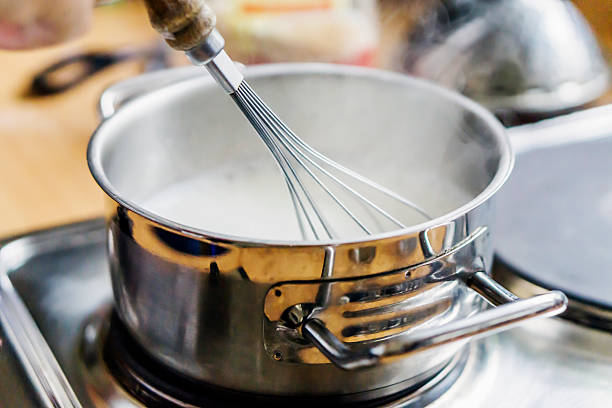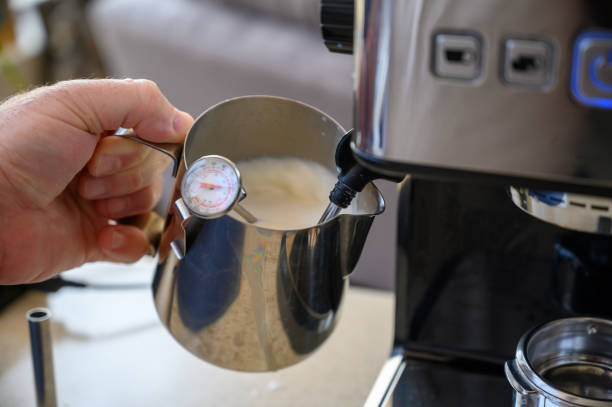Creating the perfect cup of café-quality coffee or latte at home often feels like an elusive art, particularly when it comes to achieving that silky, frothy milk texture without the aid of a professional steamer. Steaming milk is a crucial step in coffee preparation, transforming an ordinary cup of coffee into a luxurious, creamy delight. However, the absence of a steamer shouldn’t deter you from crafting your perfect coffee experience. In this comprehensive guide, “How To Steam Milk Without A Steamer,” we delve into the secrets of achieving that perfect froth, ensuring you no longer need to rely on expensive equipment or frequent visits to your local café.
Our expertise in the nuances of coffee preparation shines through as we explore alternative methods to steam milk, using tools and appliances you likely already have in your kitchen. This article not only demonstrates the value of mastering these techniques but also opens up a world of creativity and customization in your coffee making. From using a microwave and a jar to improvising with a whisk or French press, we cover a variety of methods that cater to every skill level and kitchen setup.
Join us as we embark on this journey to elevate your home coffee experience. Whether you’re a seasoned barista or a coffee enthusiast looking to expand your skills, this guide promises to pique your curiosity and enhance your appreciation for the art of coffee making. Discover the joy of creating that perfect, barista-level froth in your own home, turning your everyday coffee routine into an extraordinary ritual.
The Essentials of Steaming Milk
Understanding Steamed Milk
Steamed milk is milk that has been heated and aerated to transform its texture. When air is incorporated into hot milk through swirling or pumping, steam expands the milk’s natural sugars and fats, creating a light, frothy foam.
This steamed milk is a fundamental component of popular espresso drinks like lattes, cappuccinos, and macchiatos. The airy microfoam lightens the espresso’s intensity and adds sweetness, while the heated milk lends body and creaminess. Well-steamed milk brings balance, enhances flavor, and creates the perfect coffee-drinking experience.
Why Steam Milk?
Steaming milk before adding it to coffee offers several benefits:
- Texture – Heating and aerating milk gives it a rich, creamy texture completely different from plain milk. This luscious mouthfeel pairs perfectly with espresso.
- Sweetness – The heat of steaming causes lactose (milk sugar) to caramelize slightly, enhancing natural sweetness. The foam also incorporates air which lightens the flavor.
- Temperature – Steaming warms milk to optimal coffee-blending temperatures around 150-160°F. This preserves the drink’s heat as the espresso and milk combine.
Properly steaming milk drastically improves coffee beverages, so it’s a skill every coffee lover should know.

Choosing Your Milk
Types of Milk for Steaming
Many varieties of milk can be steamed, each with its advantages:
- Whole milk creates rich, velvety microfoam but higher fat content means faster spoilage. Best for indulgent drinks.
- 2% or nonfat milk foams easily, and lasts longer refrigerated but lacks the creamy texture of whole milk. Lower calories.
- Soy, oat, and almond milk work well foamed but lack dairy’s sweetness. Must actively incorporate air when steaming.
- Half and half are hard to froth into fine microfoam so best used for beverages with little or no foam.
Consider personal tastes, nutrition, and environmental factors when choosing milk. Experiment to find your perfect match!
Preparing Your Milk
- Always start with cold milk straight from the fridge. Warm milk won’t foam properly.
- Good quality milk with higher fat and protein foams better. Avoid ultrapasteurized or homogenized milk.
- Portion sizes: About 4 oz. steamed milk tops a single shot of espresso. 8 oz. for double-shot drinks.
How to Steam Milk without a Steamer?
To steam milk without a steamer, you can use various methods that are easy and effective:
Microwave Method:
- Pour milk into a glass jar, filling it no more than halfway.
- Shake the jar vigorously until the milk doubles in volume.
- Microwave the jar without the lid for 30 seconds.
- Pour the frothy milk into your drink or enjoy it separately.
Stovetop Method:
- Warm the milk in a small saucepan on low heat until it reaches 140°F (60°C).
- Transfer the warm milk to a clean French press and pump the plunger up and down for about 60 seconds until frothy.
- Alternatively, whisk the warm milk in a bowl with a hand mixer.
Whisking Method:
- Pour warm milk into a pot.
- Use an electric or hand whisk to froth the milk by infusing air into it.
- This method creates better foam than shaking in a jar and is suitable for making espresso coffee.
Frothing Wand Method:
- Heat the milk on the stove or in the microwave.
- Use a frothing wand to create perfect foam by blending air into the milk.
- Adjust the frothiness by heating the milk further if needed
Hand Blender Method:
- Heat milk in a pot.
- Submerge a hand blender in the milk and blend until frothy with tiny bubbles.
- This method is convenient and produces good foam similar to using an electric whisker.
See more : Does Milk Tea Have Caffeine: Yes or No? Get the Facts Here!
These methods offer simple ways to achieve steamed, frothy milk at home without the need for specialized equipment, allowing you to enjoy creamy beverages like lattes and cappuccinos.
Perfecting Your Steaming Milk Technique
Advanced Frothing Techniques
With practice, you can master advanced steaming techniques and even create latte art using DIY methods:
- Microfoam – Ultrafine, glossy milk foam is the key to latte art. Use a thermometer and stop steaming just before milk reaches 160°F.
- Troubleshoot – Thick foam means overheated. Tiny bubbles indicate not enough aeration. Adjust timing and whisking vigor.
- Etching – Pour milk into espresso pitted with a spoon to etch patterns.
- Free pouring – Tilt cup and wiggle pour spout back and forth to create hearts, rosettas, and more. Patience and trial-and-error are required.
Health and Safety Tips for Steaming Milk without a Steamer
When steaming milk yourself:
- Always start with clean equipment free of residue. Rinse all tools thoroughly.
- Use fresh, cold milk and discard any unused steamed milk rather than re-refrigerating.
- Be careful when heating milk to avoid scorching or boiling over which can cause serious burns.
- Allow heated milk to rest a minute before handling to prevent accidental scalding.
With some common precautions, you can safely enjoy deliciously steamed milk drinks!
Beyond the Basics of Steaming Milk
Flavor Enhancements
Once you’ve mastered basic steaming, try these ideas to take your milk to the next level:
- Add vanilla, cinnamon, cardamom, or other spices to the milk before steaming. Sweet and spicy.
- Stir in honey or maple syrup for a hint of natural sweetness.
- Swap regular milk for coconut or almond milk for a new twist.
- Top with nutmeg, chocolate shavings, or even whipped cream for an indulgent treat.
The options are endless – have fun and get creative.
Equipment Care and Maintenance
Caring for your DIY steaming equipment ensures delicious results every time:
- Clean thoroughly after each use. Milk residue can sour if left behind.
- Allow containers to dry fully before storage for bacteria prevention.
- De-scale French presses or metal pots periodically by boiling water and vinegar to remove mineral deposits.
- Replace whisks displaying bent, frayed wires or handles cracking from heat damage.
- Check gaskets on lids and plungers to ensure a tight seal during frothing.
Proper equipment upkeep lets you keep steaming milk like a pro!
Steaming Milk Like a Pro
Expert Insights and Case Studies
Want to take your milk steaming skills to barista levels? Advice from the pros can help you achieve cafe-quality foam at home:
According to award-winning barista Chris R., “Getting the right ‘stretch’ when aerating is key. Plunging the steam wand deep into the milk, then raising it slowly to roll foam on top increases elasticity for that smooth, glossy texture.”
See more : What Does Taro Milk Tea Taste Like? Unveiling Its True Flavor
Diego B., who competes in latte art throwdowns, warns against overheating. “I watch the thermometer closely, stopping just before 160°F. Any hotter and the bubbles can collapse.”
With experimentation and persistence, you too can become a milk steaming virtuoso using basic kitchen tools!
Review of Manual and Electric Frothers
While manual DIY methods work great, specialty milk frothing tools can streamline steaming:
- Handheld frothers – Quick and easy but produce a thinner foam. Great for beginning latte artists on a budget.
- Standing milk frothers – Automated temperature controls and more power for denser, creamier foam.
- Battery frothers – Convenient option for travel or office use. Requires frequent battery replacement.
Consider cost, storage space, frequency of use, and desired foam quality when investing in specialty equipment. Some sacrifice the hands-on finesse of manual techniques.
How To Get Steamed Milk Just Right?
Now that you know how to steam milk without a steamer, it’s important to understand how to get the perfect consistency and texture. Here are some tips to help you achieve velvety smooth steamed milk every time:
- Use whole or 2% milk for best results. Skim or non-dairy milk can also be used but may not produce as much foam.
- Make sure you’re using a clean jar, French press, or whisk before steaming your milk.
- Experiment with the amount of time and intensity when shaking or frothing the milk to achieve your desired level of foam.
- Watch the temperature carefully – aim for between 150-155°F (65-68°C) for steamed milk.
With these tips and tricks, you can now easily make steamed milk at home without the need for a fancy steamer. Enjoy your homemade cafe-style drinks, and impress your friends and family with your newfound barista skills. So, go grab that jar or whisk, heat up some milk, and get ready to elevate your coffee game with perfectly steamed milk.

Ways To Enjoy Steamed Milk
Steamed milk is not only perfect for adding to your coffee drinks, but it can also be enjoyed on its own. Here are some ways you can enjoy steamed milk:
- Add a dash of vanilla or cinnamon to your steamed milk for a delicious flavored drink.
- Top off your hot chocolate with steamed milk instead of water for a creamier and richer taste.
- Use steamed milk to make a delicious chai latte at home.
- Get creative and use steamed milk in your baking – it can add a unique flavor and texture to cakes, muffins, and more.
The possibilities are endless with steamed milk. So go ahead and try out these different ways to enjoy it.
Conclusion: How to Steam Milk without a Steamer?
With a bit of technique, milk straight from your fridge can transform into sweet, delectable cappuccino foam. Mastering the art of steaming opens up a world of possibilities, limited only by your creativity. Whether you’re craving a simple weekday latte or some soothing steamed milk on a lazy weekend, this guide equips you with everything needed to elevate your coffee – no fancy equipment required. So try a new method, play with some flavors, and share your foam adventures with fellow milk-frothing enthusiasts. The joys of steamed milk await.
FAQ: Steamed Milk
How do you steam milk without a steamer and microwave?
- Grab a saucepan and pour in the amount of milk you want.
- Put the saucepan on medium heat and start stirring with a whisk to create some foam.
- Keep an eye on it until the milk is nice and hot, and the foam reaches your desired level.
- Take the saucepan off the heat.
- Now, just pour the steamed milk into your coffee and spoon that delicious foam on top.
Is there a way to steam milk at home?
It’s super easy. Just pour some milk into a saucepan, turn on the stove to low-medium heat, and start whisking away with a balloon whisk. Be careful not to make a mess. Or, if you prefer, you can use a handheld frother that does the whisking for you while the milk heats up. So simple and delicious.
Is steamed milk just hot milk?
Nope, they’re not the same. Steamed milk is actually heated with steam, not just any old method. When you steam milk, you use a steam wand to add steam to the milk, and the end result is super creamy and dreamy. The steaming process breaks down the fat in the milk and creates tiny little bubbles. So, if you want your milk to be extra delicious and velvety, go for steamed milk, not just plain old hot milk.


Ronald B Gamrot is the owner of Silverking Brewery, one of the most successful craft breweries in North America. He started the business from scratch in his garage, and it has since grown into a multimillion-dollar operation. Ronald is passionate about brewing delicious beer and providing top-notch customer service. He is a respected member of the brewing community and often speaks at industry events.





Cheapest way to make Steamed Milk?
Is it possible to foam milk WITHOUT a steam wand?
If you have a french press you can microwave the milk in the french press. After its semi hot put the plunger on it and move it up and down really fast. Try not to spill the milk out, but it will foam the milk pretty good.
My dad got an old Krupps espresso machine from goodwill for $3. He opened it up and sealed off the pipes where the water would normally flow into the portafilter. Now it’s just a high pressure steam vessel that’s perfect for steaming milk to pour on top of our Aeropress brew.
Bodum makes a thing that you put milk into and pump up and down to create foam but an aerolatte is better.. It does an OK job.
Thanks for your information.